Yamaha NYTRO, RS RAGE, NYTRO ER, RS VECTOR GT, RS VECTOR ER Manual

SNOWMOBILE
OWNER’S MANUAL
RS90NW
RS90RW/RS90NRW
RS90MW/RS90MSW
RS90GTW
RSG90W/RSG90GTW
LIT-12628-02-55 |
8GG-28199-12 |


E_8gg.book Page 1 Thursday, March 16, 2006 4:23 PM
A
B
C
ESU00286
MACHINE IDENTIFICATION
Identification number records
A.FRAME NUMBER:
B.ENGINE NUMBER (PRIMARY ID):
C.KEY NUMBER:
Record the frame number, engine number (Primary ID), and key number in the spaces provided for assistance when ordering spare parts from a Yamaha dealer.
1 The frame number is the seventeen-digit number stamped on the frame of the snowmobile. (See fig. È.)
2 The engine number is stamped in the location as shown. (See fig. É.)
3 Key number (See fig. Ê.)
Also, record and keep the ID numbers in a separate place in case the snowmobile is stolen.
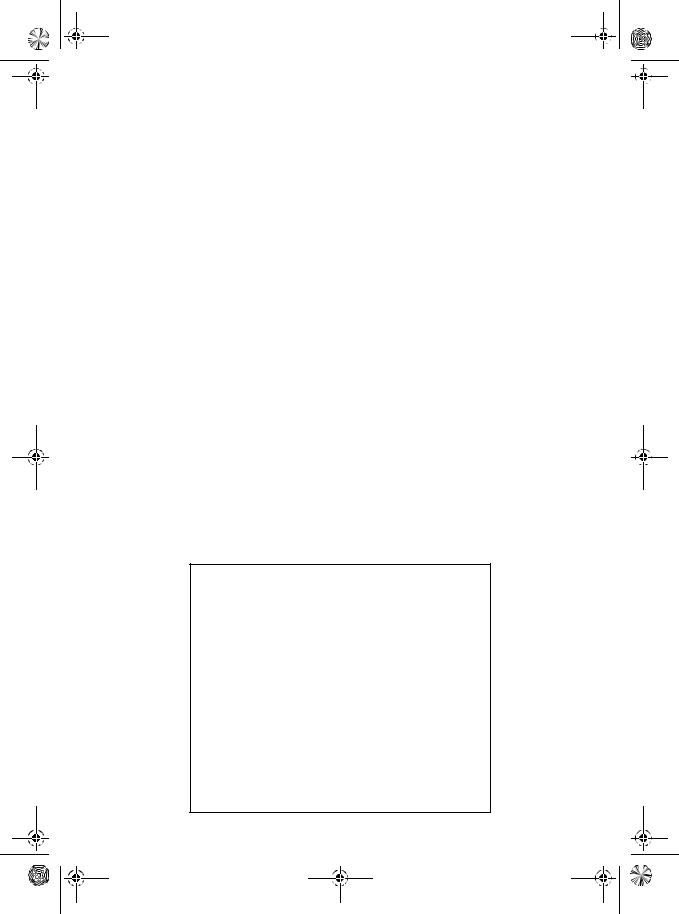
E_8gg.book Page 1 Thursday, March 16, 2006 4:23 PM
ESU00011
INTRODUCTION
Congratulations on your purchase of a Yamaha snowmobile. This model is the result of Yamaha’s vast experience in the production of fine sporting and touring snowmobiles. It represents the high degree of craftsmanship and reliability that have made Yamaha a leader in these fields.
This manual will give you an understanding of the operation, inspection, and basic maintenance of this snowmobile. If you have any questions concerning the operation or maintenance of your snowmobile, please consult a Yamaha dealer.
To maintain the high quality and performance of this snowmobile, it is important that you and your Yamaha dealer pay close attention to the recommended maintenance schedules and operating instructions contained within this manual.
RS90NW
RS90RW/RS90NRW
RS90MW/RS90MSW
RS90GTW
RSG90W/RSG90GTW
OWNER’S MANUAL
©2006 by Yamaha Motor Corporation, U.S.A. 1st Edition, March 2006
All rights reserved.
Any reprinting or unauthorized use without the written permission of Yamaha Motor Corporation, U.S.A. is expressly prohibited.
Printed in Japan
P/N LIT-12628-02-55
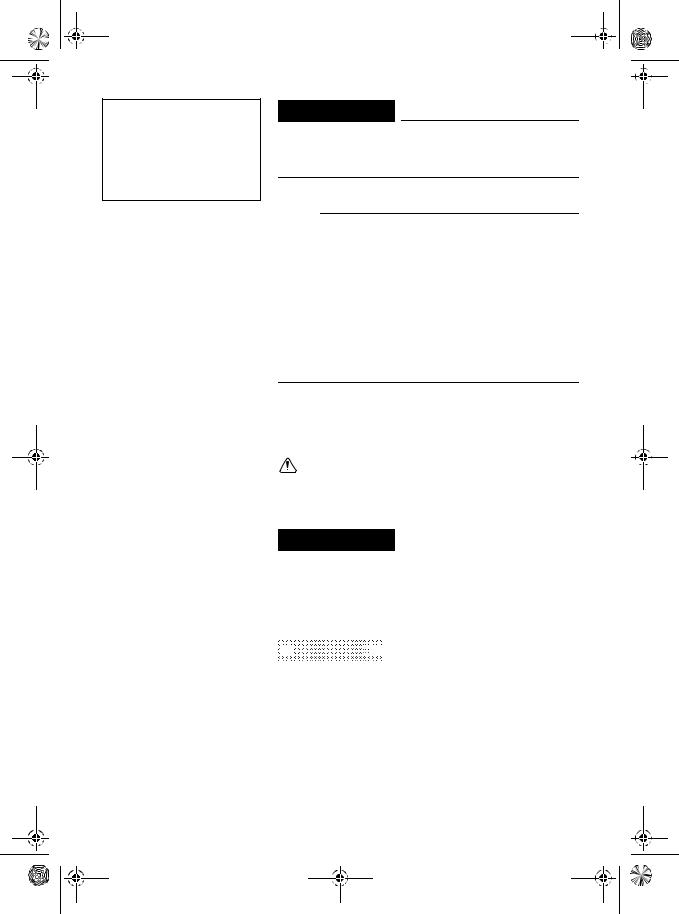
E_8gg.book Page 2 Thursday, March 16, 2006 4:23 PM
 WARNING
WARNING
PLEASE READ AND UNDERSTAND THIS MANUAL COMPLETELY BEFORE OPERATING THE SNOWMOBILE.
NOTE:
●Yamaha continually seeks advancements in product design and quality. Therefore, while this manual contains the most current product information available at the time of printing, there may be minor discrepancies between your snowmobile and this manual. If there is any question concerning this manual, please consult a Yamaha dealer.
●This manual should be considered a permanent part of this snowmobile and should remain with the snowmobile when resold.
Particularly important information is distinguished in this manual by the following notations.
The Safety Alert Symbol means ATTENTION! BECOME ALERT! YOUR SAFETY IS INVOLVED!
 WARNING
WARNING
Failure to follow WARNING instructions could result in severe injury or death to the snowmobile operator, a bystander, or a person inspecting or repairing the snowmobile.


 CAUTION
CAUTION :
:



@
A CAUTION indicates special precautions that must be taken to avoid damage to the snowmobile.
NOTE:
A NOTE provides key information to make procedures easier or clearer.

E_8gg.book Page 1 Thursday, March 16, 2006 4:23 PM
ESU00003
CONTENTS
|
YAMAHA MOTOR |
|
|
|
CORPORATION, U.S.A. |
|
|
|
SNOWMOBILE LIMITED |
|
|
|
WARRANTY ....................................... |
1-1 |
|
|
YAMAHA EXTENDED SERVICE |
|
|
|
(Y.E.S.) ............................................... |
1-4 |
|
|
LOCATION OF THE |
|
|
|
IMPORTANT LABELS ....................... |
2-1 |
|
|
SAFETY INFORMATION ................... |
3-1 |
|
|
DESCRIPTION ................................... |
4-1 |
|
|
CONTROL FUNCTIONS .................... |
5-1 |
|
|
|
Main switch...................................... |
5-1 |
|
|
Starter lever (choke) ........................ |
5-2 |
|
|
Throttle lever.................................... |
5-2 |
|
|
Engine overheating prevention |
|
|
|
system ............................................. |
5-2 |
|
|
Throttle override system |
|
|
|
(T.O.R.S.) ........................................ |
5-3 |
|
|
Speedometer unit ............................ |
5-4 |
|
|
High beam indicator light ................. |
5-4 |
|
|
Fuel meter and grip/thumb |
|
|
|
warmer level indicator...................... |
5-5 |
|
|
Fuel level warning indicator ............. |
5-6 |
|
|
Oil level warning indicator................ |
5-6 |
|
|
Low coolant temperature |
|
|
|
indicator light ................................... |
5-6 |
|
|
Coolant temperature warning |
|
|
|
indicator ........................................... |
5-7 |
|
|
Self-diagnostic system..................... |
5-7 |
|
|
Engine stop switch........................... |
5-8 |
|
|
Brake lever ...................................... |
5-8 |
|
|
Parking brake lever.......................... |
5-9 |
|
|
Shift lever......................................... |
5-9 |
|
|
Headlight beam switch .................. |
5-10 |
|
|
Auxiliary DC jack ........................... |
5-10 |
|
|
Shroud latches............................... |
5-11 |
|
|
|
|
|
|
|
|
|
|
|
|
Drive guard .................................... |
5-11 |
|
|
V-belt holders ................................ |
5-11 |
|
|
Carburetor coolant shut-off |
|
|
|
lever............................................... |
5-12 |
|
|
Rear suspension damping force |
|
|
|
remote adjustment dial .................. |
5-12 |
|
|
Storage compartment .................... |
5-12 |
|
|
Rear carrier ................................... |
5-13 |
|
|
PRE-OPERATION CHECKS.............. |
6-1 |
|
|
Fuel ................................................. |
6-1 |
|
|
Engine oil......................................... |
6-2 |
|
|
Engine oil level ................................ |
6-3 |
|
|
Coolant ............................................ |
6-4 |
|
|
Throttle lever ................................... |
6-5 |
|
|
Throttle override system |
|
|
|
(T.O.R.S.) ........................................ |
6-5 |
|
|
Brake ............................................... |
6-6 |
|
|
Brake fluid leakage .......................... |
6-7 |
|
|
V-belt ............................................... |
6-7 |
|
|
Drive guard ...................................... |
6-7 |
|
|
Drive track ....................................... |
6-8 |
|
|
51-mm (2.0-in) high-profile |
|
|
|
pattern drive track............................ |
6-8 |
|
|
Slide runners ................................... |
6-9 |
|
|
Skis and ski runners ........................ |
6-9 |
|
|
Steering system............................. |
6-10 |
|
|
Lights ............................................. |
6-10 |
|
|
Air filter .......................................... |
6-10 |
|
|
Fittings and fasteners .................... |
6-11 |
|
|
Tool kit and recommended |
|
|
|
equipment...................................... |
6-11 |
|
|
OPERATION ...................................... |
7-1 |
|
|
Starting the engine .......................... |
7-1 |
|
|
Break-in ........................................... |
7-2 |
|
|
Riding your snowmobile .................. |
7-3 |
|
|
Getting to know your snowmobile ... |
7-3 |
|
|
Learning to ride your snowmobile ... |
7-3 |
|
|
To start out and accelerate.............. |
7-3 |
|
|
Braking ............................................ |
7-3 |
|
|
Turning ............................................ |
7-4 |
|
|
|
|
|
|
|
|
|
|
|
|
|
|
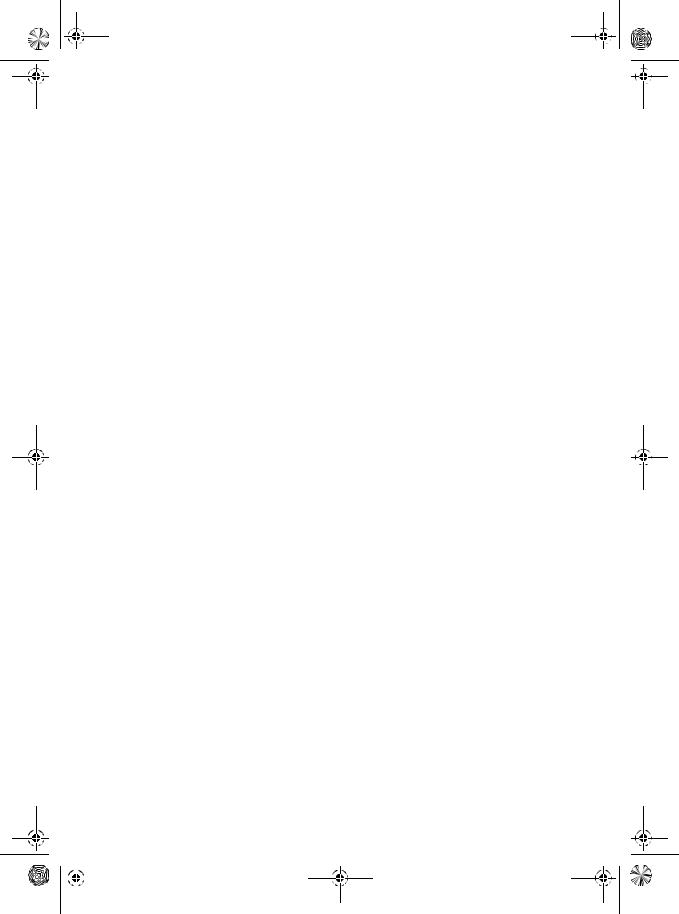
E_8gg.book Page 2 Thursday, March 16, 2006 4:23 PM
|
|
Riding uphill ..................................... |
7-4 |
|
|
Riding downhill ................................ |
7-5 |
|
|
Traversing a slope ........................... |
7-5 |
|
|
Ice or icy surface ............................. |
7-5 |
|
|
Hard-packed snow........................... |
7-6 |
|
|
Operation on surfaces other than |
|
|
|
snow or ice ...................................... |
7-6 |
|
|
Maximizing drive track life ............... |
7-7 |
|
|
Strap ................................................ |
7-8 |
|
|
Driving ............................................. |
7-9 |
|
|
Stopping the engine....................... |
7-10 |
|
|
Transporting .................................. |
7-11 |
|
PERIODIC MAINTENANCE ............... |
8-1 |
|
|
|
Periodic maintenance chart for the |
|
|
|
emission control system .................. |
8-1 |
|
|
General maintenance and |
|
|
|
lubrication chart ............................... |
8-2 |
|
|
Tool kit ............................................. |
8-5 |
|
|
Checking the spark plugs ................ |
8-5 |
|
|
Adjusting the engine idling speed.... |
8-7 |
|
|
Adjusting the throttle cable .............. |
8-7 |
|
|
Adjusting the carburetors................. |
8-7 |
|
|
Adjusting the high-altitude |
|
|
|
settings ............................................ |
8-8 |
|
|
Adjusting the valve clearance.......... |
8-8 |
|
|
Changing the engine oil................... |
8-9 |
|
|
Cooling system .............................. |
8-12 |
|
|
Replacing the V-belt ...................... |
8-14 |
|
|
Checking the drive chain |
|
|
|
housing oil level and the drive |
|
|
|
chain tension ................................. |
8-16 |
|
|
Checking the brake pads............... |
8-18 |
|
|
Checking the parking brake |
|
|
|
pads............................................... |
8-18 |
|
|
Checking the brake fluid level........ |
8-19 |
|
|
Changing the brake fluid................ |
8-19 |
|
|
Suspension.................................... |
8-19 |
|
|
Adjusting the drive track ................ |
8-31 |
|
|
Aligning the skis............................. |
8-33 |
|
|
Adjusting the handlebar................. |
8-33 |
|
|
Lubrication ..................................... |
8-35 |
|
|
Replacing a headlight bulb ............ |
8-36 |
|
|
Adjusting the headlight beam ........ |
8-36 |
|
|
Battery ........................................... |
8-37 |
|
|
Replacing a fuse............................ |
8-37 |
|
|
|
|
|
|
|
|
|
|
|
|
TROUBLESHOOTING |
.......................9-1 |
STORAGE ........................................ |
10-1 |
SPECIFICATIONS............................ |
11-1 |
Dimensions.................................... |
11-1 |
Engine ........................................... |
11-1 |
Chassis.......................................... |
11-2 |
Electric........................................... |
11-4 |
WIRING DIAGRAM .......................... |
12-1 |
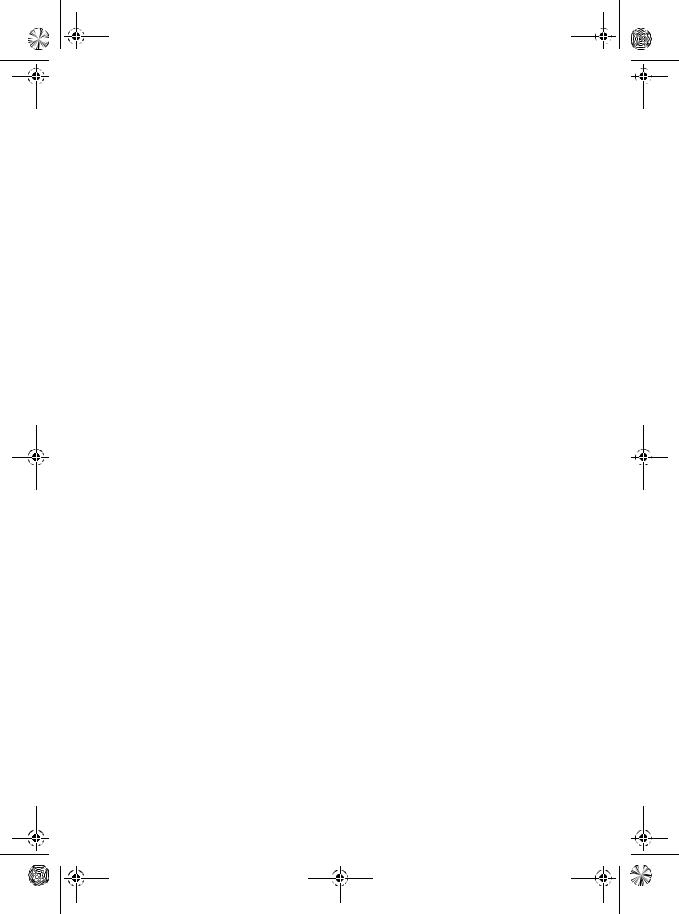
E_8gg.book Page 1 Thursday, March 16, 2006 4:23 PM
ESU05070
YAMAHA MOTOR CORPORATION, U.S.A.
SNOWMOBILE LIMITED WARRANTY
Yamaha Motor Corporation, U.S.A. hereby warrants that new Yamaha snowmobiles purchased from an authorized Yamaha snowmobile dealer in the continental United States will be free from defects in material and workmanship for the period of time stated herein, subject to certain stated limitations.
WARRANTY PERIOD:
1.All Yamaha snowmobiles shall be warranted for a term of one (1) year from the date of purchase, plus a special early-season extension (if applicable).
2.All Yamaha snowmobile clutch components are warranted against abnormal wear for one (1) year from the date of purchase, plus a special early-season extension (if applicable).
DURING THE PERIOD OF WARRANTY any authorized Yamaha snowmobile dealer will, free of charge, repair or replace, at Yamaha’s option, any part adjudged defective by Yamaha due to faulty workmanship or material from the factory. Parts used in warranty repairs will be warranted for the balance of the snowmobile’s warranty period. All parts replaced under warranty become the property of Yamaha Motor Corporation, U.S.A.
GENERAL EXCLUSIONS from this warranty shall include any failures to the machine caused by:
1.Competition, racing, or non-Yamaha authorized rental use.
2.Operation on surfaces other than snow or ice.
3.Installation of parts or accessories that are not qualitatively equivalent to genuine Yamaha parts.
4.Abnormal strain, neglect, or abuse.
5.Lack of proper maintenance.
6.Accident or collision damage.
7.Modification to original parts.
SPECIFIC EXCLUSIONS from this warranty shall include parts replaced due to normal wear or routine maintenance including oil, spark plugs, clutch drive belts, slide runners, and track.
THE CUSTOMER’S RESPONSIBILITY under this warranty shall be to:
1.Operate and maintain the snowmobile as specified in the appropriate Owner’s Manual.
2.Give notice to an authorized Yamaha snowmobile dealer of any and all apparent defects within ten (10) days after discovery, and make the machine available at that time for inspection and repairs at such dealer’s place of business. You may locate your nearest authorized Yamaha dealer through your local telephone directory.
WARRANTY TRANSFER: To transfer any remaining warranty from the original purchaser to any subsequent purchaser, it is imperative that the machine be inspected and registered for warranty by an authorized Yamaha snowmobile dealer. In order for this warranty to remain in effect, this inspection and registration must take place within ten (10) days after ownership transfer. An inspection and registration fee will be charged for this service.
EMISSION CONTROL SYSTEM WARRANTY
Yamaha Motor Corporation, USA also warrants to the ultimate purchaser and each subsequent purchaser of each 2006 and later model Yamaha snowmobile covered by this warranty that the vehicle is designed, built, and equipped so as to conform at the time of sale with all U.S. emissions standards applicable at the time of manufacture and that it is free from defects in materials and workmanship which would cause it not to meet these standards within the period listed immediately below. Failures other than those resulting from defects in material or workmanship which arise solely as a result of owner abuse and/or lack of proper maintenance are not covered by this warranty.
All Models
Thirty (30) months from the original purchase date
1-1
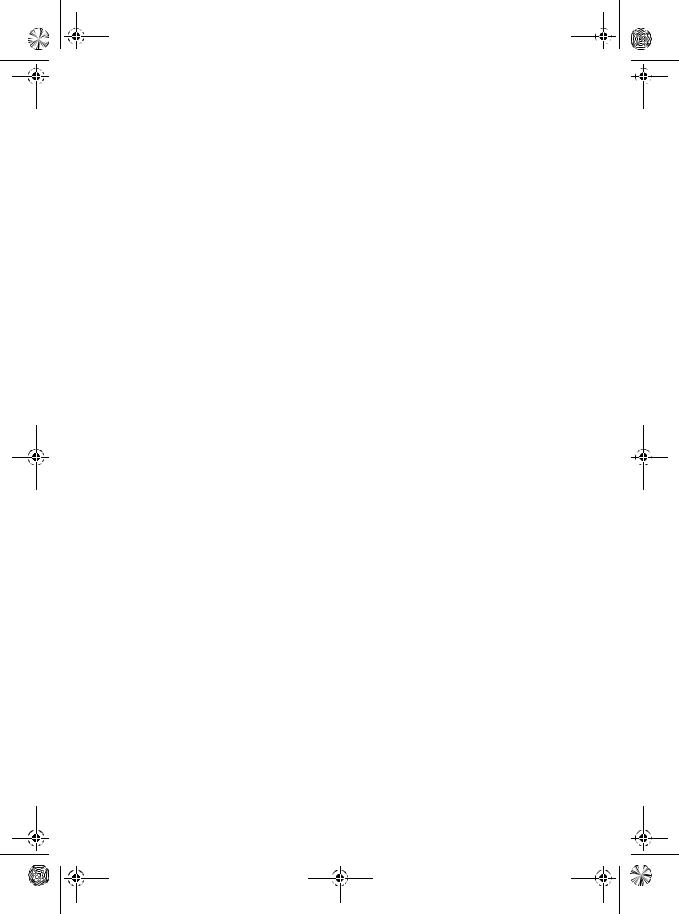
E_8gg.book Page 2 Thursday, March 16, 2006 4:23 PM
YAMAHA MOTOR CORPORATION, U.S.A. MAKES NO OTHER WARRANTY OF ANY KIND, EXPRESSED OR IMPLIED. ALL IMPLIED WARRANTIES OF MERCHANTABILITY AND FITNESS FOR A PARTICULAR PURPOSE WHICH EXCEED THE OBLIGATIONS AND TIME LIMITS STATED IN THIS WARRANTY ARE HEREBY DISCLAIMED BY YAMAHA MOTOR CORPORATION, U.S.A. AND EXCLUDED FROM THIS WARRANTY.
SOME STATES DO NOT ALLOW LIMITATIONS ON HOW LONG AN IMPLIED WARRANTY LASTS, SO THE ABOVE LIMITATION MAY NOT APPLY TO YOU. ALSO EXCLUDED FROM THIS WARRANTY ARE ANY INCIDENTAL OR CONSEQUENTIAL DAMAGES INCLUDING LOSS OF USE. SOME STATES DO NOT ALLOW THE EXCLUSION OR LIMITATION OF INCIDENTAL OR CONSEQUENTIAL DAMAGES, SO THE ABOVE EXCLUSION MAY NOT APPLY TO YOU.
THIS WARRANTY GIVES YOU SPECIFIC LEGAL RIGHTS, AND YOU MAY ALSO HAVE OTHER RIGHTS WHICH VARY FROM STATE TO STATE.
SPECIAL EARLY-SEASON WARRANTY EXTENSION
A special warranty extension is available for all new Yamaha snowmobiles purchased between June 1 and December 1.
All new Yamaha snowmobiles purchased between June 1 and December 1 will have the warranty extended to November 30 of the following year.
YAMAHA MOTOR CORPORATION, U.S.A.
Post Office Box 6555
Cypress, California 90630
WARRANTY QUESTIONS AND ANSWERS
Q.What costs are my responsibility during the warranty period?
A.The customer’s responsibility includes all costs of normal maintenance services, non-warranty repairs, accident and collision damages, as well as oil, spark plugs, clutch drive belts, and slide runners.
Q.What are some examples of “abnormal” strain, neglect, or abuse?
A.These terms are general and overlap each other in areas. Specific examples include: Running the machine out of oil, hitting an object submerged under snow, operation on surfaces other than snow or ice, operating the machine with a broken or damaged part which causes another part to fail, and so on. If you have any specific questions on operation or maintenance, please contact your dealer for advice.
Q.May I perform any or all of the recommended maintenance shown in the Owner’s Manual instead of having the dealer do them?
A.Yes, if you are a qualified snowmobile mechanic and follow the procedures specified in the Owner’s and Service Manual. We do recommend, however, that items requiring special tools or equipment be done by a Yamaha snowmobile dealer.
Q.Under what conditions is the clutch not covered by warranty?
A.Clutches as well as clutch components wear with use. Normal wear is not covered under warranty such service is the customer’s responsibility. Abnormal wear is, however, covered for one (1) year from the date of purchase. Your Yamaha snowmobile dealer possesses criteria as to what constitutes abnormal wear.
Q.Will the warranty be void or canceled if I do not operate or maintain my new Yamaha exactly as specified in the Owner’s Manual?
A.No. The warranty on a new Yamaha cannot be “voided” or “canceled.” However, if a particular failure is caused by operation or maintenance other than as shown in the Owner’s Manual, that failure may not be covered under warranty.
1-2
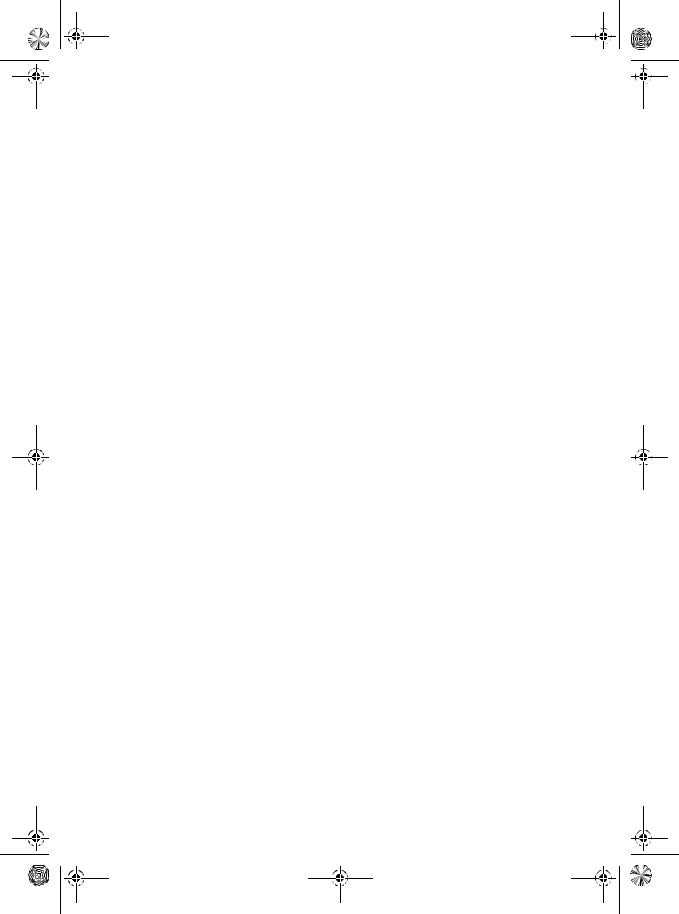
E_8gg.book Page 3 Thursday, March 16, 2006 4:23 PM
Q.What responsibility does my dealer have under this warranty?
A.Each Yamaha snowmobile dealer is expected to:
1.Completely set up every new machine before sale.
2.Explain the operation, maintenance, and warranty requirements to your satisfaction at the time of sale, and upon your request at any later date.
3.In addition, each Yamaha snowmobile dealer is held responsible for his setup, service and warranty repair work.
Q.Whom should I contact if I have further questions about this warranty?
A.Your Yamaha snowmobile dealer has the information and experience necessary to answer almost any questions about this warranty. If the dealer is not able to do so, he is expected to contact Yamaha Motor Corporation, U.S.A., for clarification or assistance.
CUSTOMER SERVICE
If your machine requires warranty service, you must take it to any authorized Yamaha snowmobile dealer within the continental United States. Be sure to bring your warranty identification card or other valid proof of the original date of purchase. If a question or problem arises regarding warranty, first contact the owner of the dealership. Since all warranty matters are handled at the dealer level, this person is in the best position to help you. If you are still not satisfied and require additional assistance, please write:
YAMAHA MOTOR CORPORATION, U.S.A.
CUSTOMER RELATIONS
DEPARTMENT
P.O. Box 6555
Cypress, California 90630
When contacting Yamaha Motor Corporation, U.S.A. be sure to include the model, serial number, names, dates, and receipts.
CHANGE OF ADDRESS
The federal government requires each manufacturer of a motor vehicle to maintain a complete, up-to-date list of all first purchasers against the possibility of a safety-related defect and recall. This list is compiled from the purchase registrations sent to Yamaha Motor Corporation, U.S.A. by the selling dealer at the time of your purchase.
If you should move after you have purchased your new snowmobile, please advise us of your new address by sending a postcard listing your snowmobile model name, engine serial number, dealer number (or dealer’s name) as it is shown on your warranty registration identification, your name and new mailing address. Mail to:
YAMAHA MOTOR CORPORATION, U.S.A.
WARRANTY DEPARTMENT
P.O. Box 6555
Cypress, California 90630
This will ensure that Yamaha Motor Corporation, U.S.A. has an up-to-date registration record in accordance with federal law.
1-3
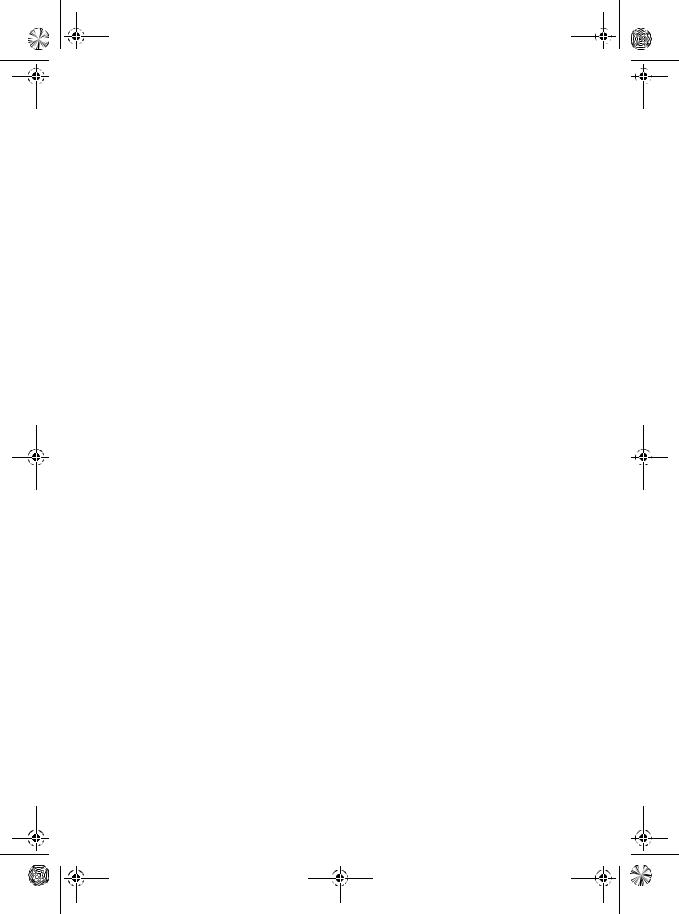
E_8gg.book Page 4 Thursday, March 16, 2006 4:23 PM
ESU04280
YAMAHA EXTENDED SERVICE (Y.E.S.)
1-4
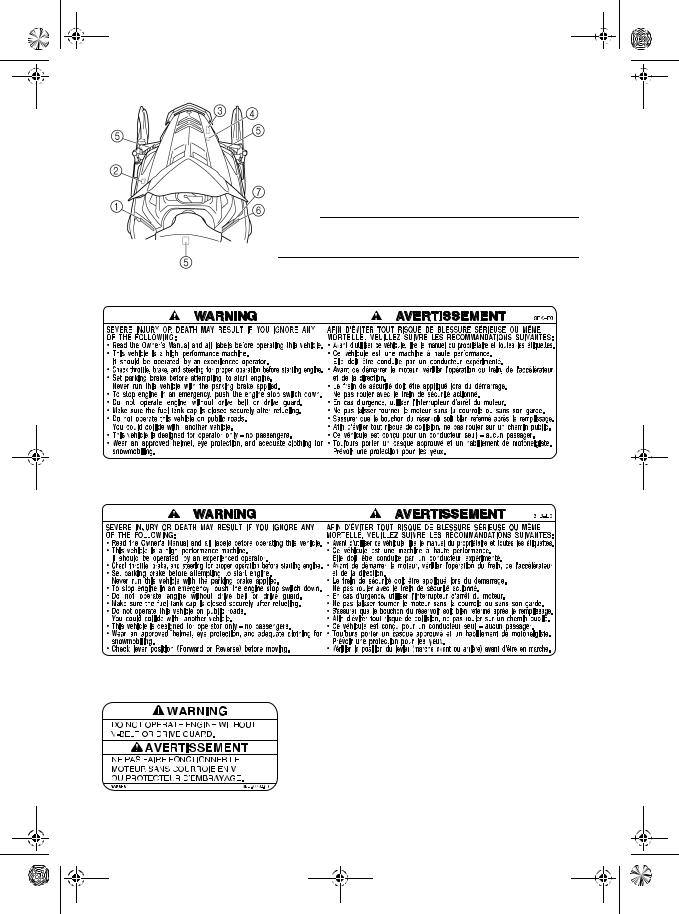
E_8gg.book Page 1 Thursday, March 16, 2006 4:23 PM
ESU04050
LOCATION OF THE IMPORTANT
LABELS
Please read the following labels carefully before operating this snowmobile.
NOTE:
Maintain or replace safety and instruction labels, as necessary.
1 RS90N/RS90M/RS90MS
8EK-77761-E0
1 RS90R/RS90NR/RS90GT/RSG90/RSG90GT
8FB-77761-E0
2
2-1
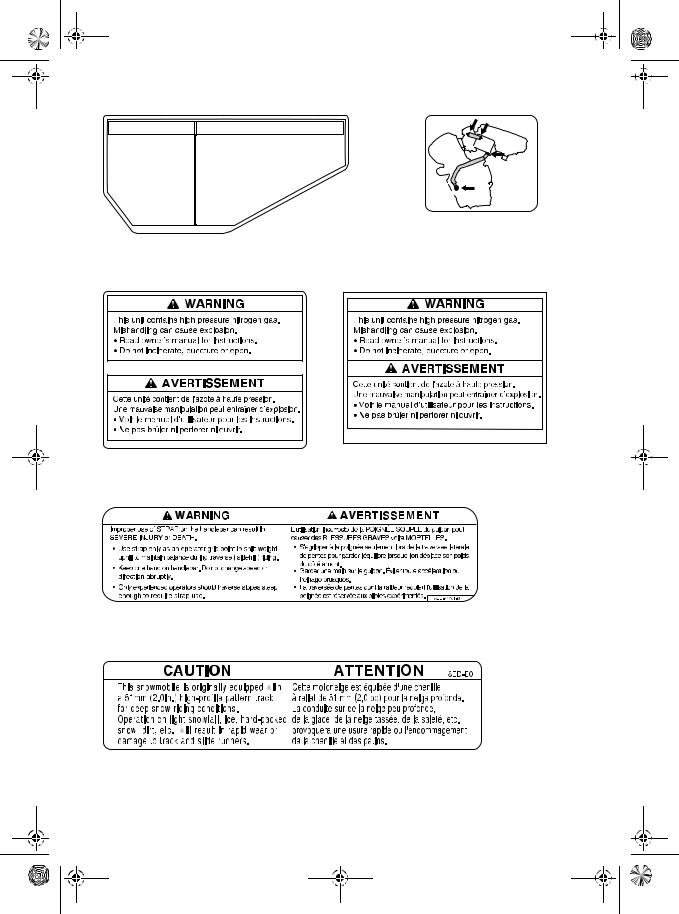
E_8gg.book Page 2 Thursday, March 16, 2006 4:23 PM
3 4
CAUTION |
ATTENTION |
|
Severe engine damage |
Des dommages graves risquent de survenir par |
|
can result from oil loss if |
suite de fuites d’huile résultant d’un mauvais |
|
crankcase breather hoses |
branchement des tuyaux de reniflard du carter. |
|
are not installed correctly. |
Après l’entretien de la batterie ou après la |
|
Inspect hoses and clamps |
dépose de l’épurateur d’air, assurez- |
|
for correct installation |
vous que les brides et les tuyaux |
|
after battery service or |
sont installès correctement. |
|
air box removal. |
Consultez le manuel |
8ES-14427-00 |
See Service Manual. |
d’entretien. |
|
|
8ES-14488-00 |
|
5 |
|
5 RS90GT/RSG90GT |
4AA-22259-70
4AA-22259-60
6 RS90M/RS90MS
7 RS90M/RS90MS
8ED-2191H-E0
2-2

E_8gg.book Page 3 Thursday, March 16, 2006 4:23 PM
8 RS90M/RS90MS/RSG90/RSG90GT
9 RS90MS
Do not use the carrier to lift the snowmobile.
Ne pas soulever la motoneige en tirant sur le porte-bagages.
8FS-24875-E0
2-3
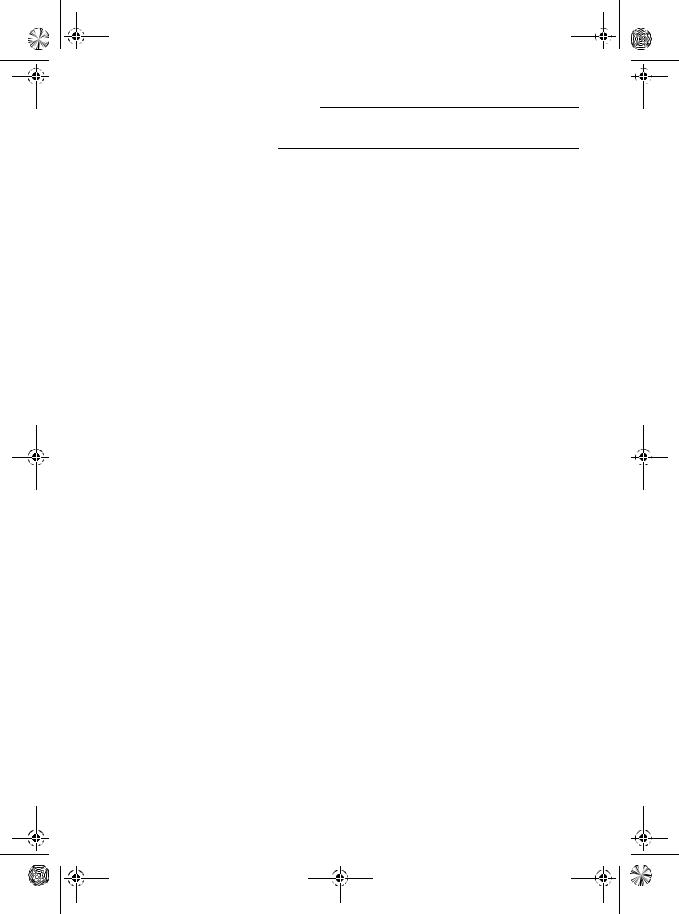
E_8gg.book Page 4 Thursday, March 16, 2006 4:23 PM
NOTE:
The following suspension adjustment charts are included with the Owner’s Manual.
RS90N/RS90NR/RS90M/RS90MS
RS90R/RS90GT/RSG90/RSG90GT
2-4
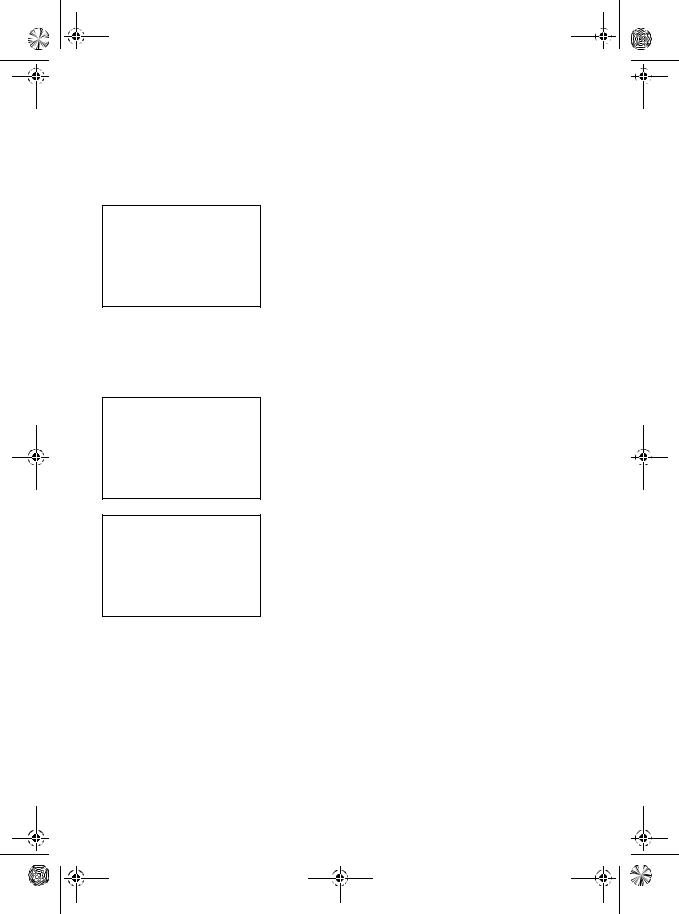
E_8gg.book Page 1 Thursday, March 16, 2006 4:23 PM
ESU00008
SAFETY INFORMATION
When you ride your snowmobile, you must know and use the following for your safety. Severe injury or death may result if you ignore any of the following.
Before operating
1.Read the Owner’s Manual and all labels before operating this snowmobile. Become familiar with all of the operating controls and their function. Consult a Yamaha dealer about any control or function you do not understand.
2.This snowmobile was not manufactured for use on public streets, roads, or highways. Such use is prohibited by law, and you could collide with another vehicle.
3.This snowmobile is designed to carry the OPERATOR ONLY.
Passengers are prohibited. Carrying a passenger can cause loss of control.
4.Do not operate the snowmobile after drinking alcohol or taking drugs. Your ability to operate the snowmobile is reduced by the influence of alcohol or drugs.
5.For safety and proper care of the snowmobile, always perform the pre-operation checks on pages 6-1–6-11 before starting the engine. Check the throttle, brake, and steering for proper operation every time before starting the engine. Make sure that the throttle lever moves freely and it returns to the home position when it is released.
6.Apply the parking brake before starting the engine. Never drive the snowmobile with the parking brake applied. This may overheat the brake disc and reduce braking ability.
3-1

E_8gg.book Page 2 Thursday, March 16, 2006 4:23 PM
7.Do not allow anyone to stand behind the snowmobile when starting, inspecting, or adjusting the snowmobile. A broken track, track fittings, or debris thrown by the track could be dangerous to the operator or bystanders.
8.Handle fuel with care; it is HIGHLY FLAMMABLE.
●Never add fuel when the engine is running or hot. Allow the engine to cool for several minutes after running.
●Use an approved fuel container.
●Fill the fuel tank outdoors with extreme care. Never remove the fuel cap indoors. Never fill the fuel tank indoors.
●Never refuel while smoking or in the vicinity of an open flame.
●Make sure that the fuel tank cap is closed securely after refueling. Wipe up any spilled fuel immediately.
9.If you swallow some gasoline, inhale a lot of gasoline vapor, or get some gasoline into your eyes, see your doctor immediately. If any gasoline spills on your skin or clothing, immediately wash your skin with soap and water, and change your clothes.
10.Wear protective clothing. Wear an approved helmet, and a face shield or goggles. Also, wear a good quality snowmobile suit, boots, and a pair of gloves or mittens that will permit use of your thumbs and fingers for operation of the controls.
Operation
1.Do not run the engine indoors, except when starting the engine to transport the snowmobile in or out of the building. Open the outside doors; exhaust fumes are dangerous.
2.Be careful where you ride. There may be obstacles hidden beneath the snow. Stay on established trails to minimize your exposure to hazards. Ride slowly and cautiously when you ride off of established trails. Hitting a rock or stump, or running into wires could cause an accident and injury.
3-2
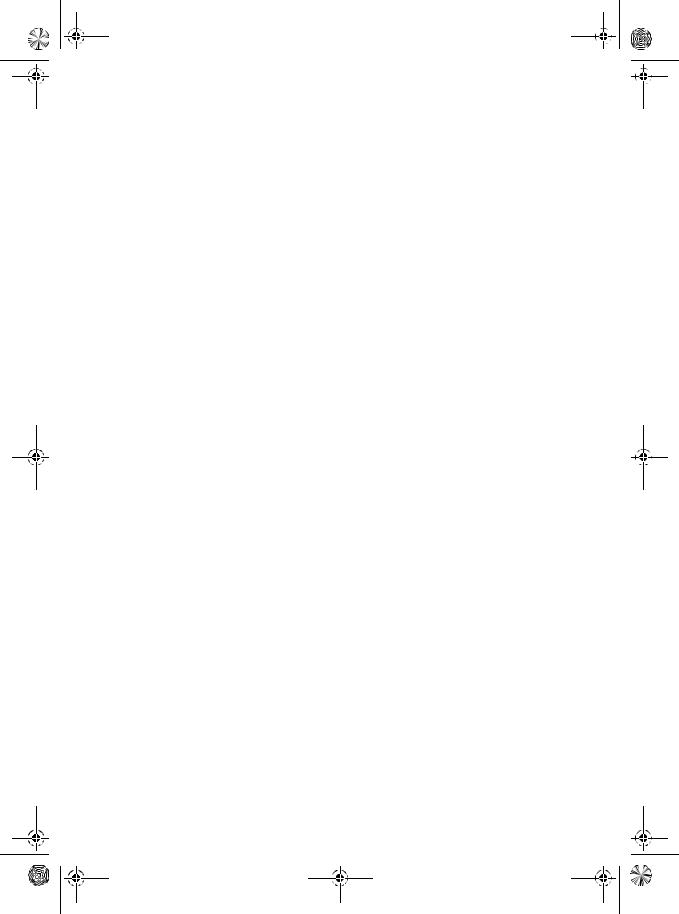
E_8gg.book Page 3 Thursday, March 16, 2006 4:23 PM
3.This snowmobile is not designed for use on surfaces other than snow or ice. Use on dirt, sand, grass, rocks, or bare pavement may cause loss of control and may damage the snowmobile.
4.Avoid operating on glare ice, or on snow which has a lot of dirt or sand mixed in. Operation under such conditions will damage or result in rapid wear of ski runners, drive track, slide runners, and drive sprockets.
5.Always ride with other snowmobilers when going on a ride. You may need help if you run out of fuel, have an accident, or damage your snowmobile.
6.Many surfaces such as ice and hard-packed snow require much longer stopping distances. Be alert, plan ahead and begin decelerating early. The best braking method on most surfaces is to release the throttle and apply the brake gently—not suddenly.
Maintenance and storage
1.Do not leave the snowmobile on its left side for an extended period of time. Fuel may leak out from the fuel breather hose.
2.Modifications made to the snowmobile not approved by Yamaha, or the removal of original equipment may render your snowmobile unsafe for use that may cause severe personal injury. Modifications may also make the snowmobile illegal to use.
3.Never store the snowmobile with fuel in the fuel tank inside a building where ignition sources are present such as hot water and space heaters, an open flame, sparks, clothes dryers, and the like. Allow the engine to cool off before storing the snowmobile in an enclosed space.
4.Always refer to the “STORAGE” section if the snowmobile is to be stored for an extended period.
5.Maintain or replace safety and instruction labels, as necessary.
3-3
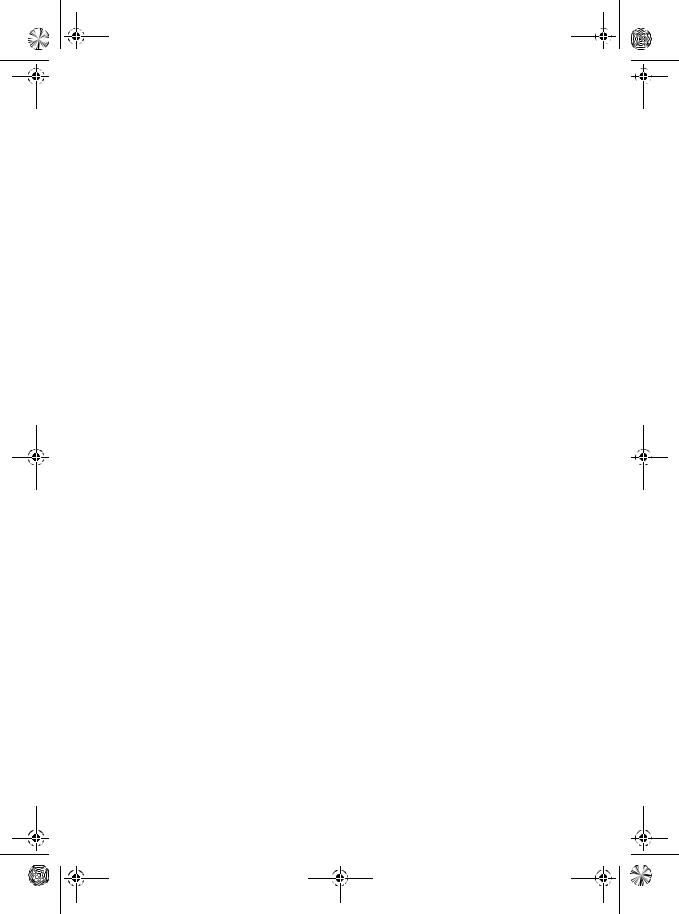
E_8gg.book Page 1 Thursday, March 16, 2006 4:23 PM
ESU00012
DESCRIPTION
RS90N/RS90NR |
RS90R/RS90GT |
RS90M
RS90MS
RSG90/RSG90GT
4-1
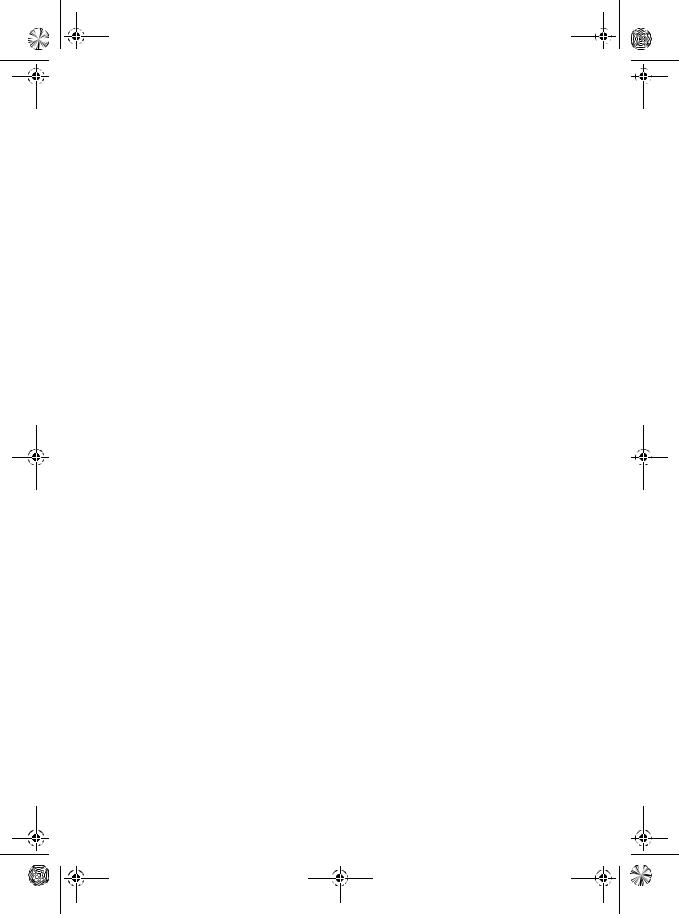
E_8gg.book Page 2 Thursday, March 16, 2006 4:23 PM
1Windshield
2Steering handlebar
3Seat
4Frame
5Storage compartment
6Rear carrier
7Slide rail suspension
8Rear suspension damping force remote adjustment dial (RS90R/RS90GT/RSG90/RSG90GT)
9Drive track
0 Skis
AHeadlights
BShroud
CStrap (RS90M/RS90MS)
DTail/brake lights
ESnow flap
FBrake lever
GParking brake lever
HGrip warmer adjustment switch
IHeadlight beam switch
JEngine stop switch
KThumb warmer adjustment switch
LThrottle lever
MShift lever (RS90R/RS90NR/RS90GT/RSG90/ RSG90GT)
NShroud latch
OMain switch
PAuxiliary DC jack (RS90GT/RSG90GT)
QStarter lever
RTachometer
SLow coolant temperature indicator light
THigh beam indicator light
UWarning light
VSelf-diagnosis warning indicator
WCoolant temperature warning indicator
XFuel level warning indicator
YOil level warning indicator
ZSpeedometer
[ Grip warmer indicator \ Select/reset button
] Thumb warmer indicator
_ Fuel meter and grip/thumb warmer level indicator
a Odometer/tripmeter
4-2

E_8gg.book Page 1 Thursday, March 16, 2006 4:23 PM
ESU00013
CONTROL FUNCTIONS
ESU00362
Main switch
The main switch controls the following items.
1 “OFF”
The ignition circuit is switched off.
The key can be removed only in this position.
2 “ON”
The ignition circuit is switched on.
3 “START”
The starting circuit is switched on. The starter motor starts.


 CAUTION
CAUTION :
:



@
Release the switch immediately after the engine starts.
NOTE:
The headlights, meter lights, and taillights come on after the engine starts.
5-1
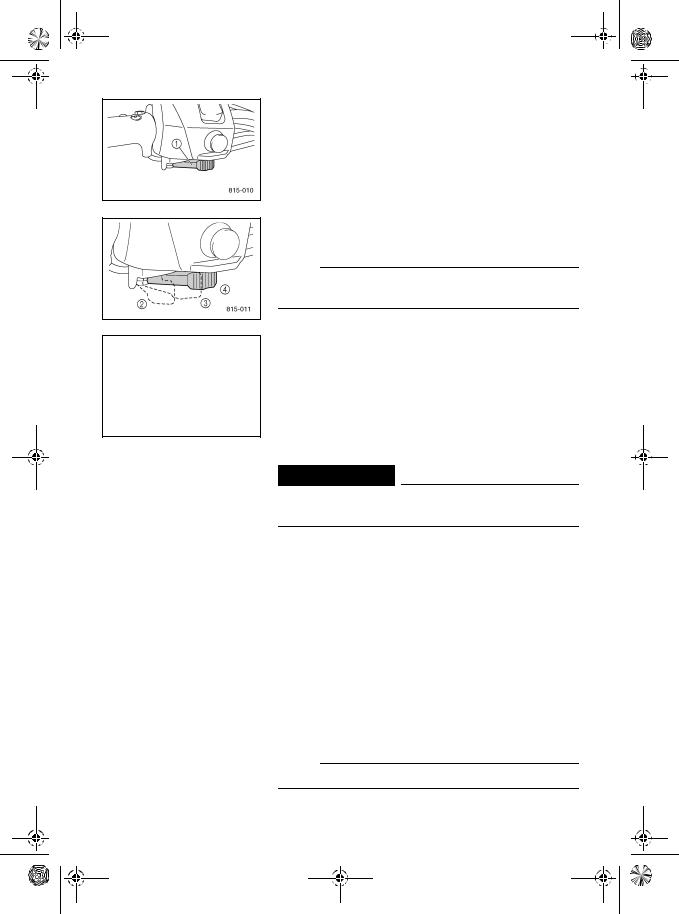
E_8gg.book Page 2 Thursday, March 16, 2006 4:23 PM
ESU00201
Starter lever (choke)
Use the starter lever (choke) when starting and warming up a cold engine.
1Starter lever (choke)
2When starting a cold engine.
3Warming up
4When the engine is warm.
NOTE:
Refer the “Starting the engine” section for proper operation.
ESU00022
Throttle lever
Once the engine is running cleanly, squeezing a the throttle lever 1 will increase the engine speed and cause engagement of the drive system. Regulate the speed of the snowmobile by varying the throttle position. Because the throttle is spring-loaded, the snowmobile will decelerate, and the engine will return to idle when it is released b.
 WARNING
WARNING
Check the throttle, brake, and steering for proper operation before starting the engine.
ESU00361
Engine overheating prevention system
This model is equipped with an engine overheating prevention system to prevent overheating when the engine is idling.
When the engine has been idling for at least 3 minutes and the coolant temperature has risen above 100 °C (212 °F), the engine automatically shuts off to prevent overheating.
NOTE:
The engine can be started after it shuts off.
5-2
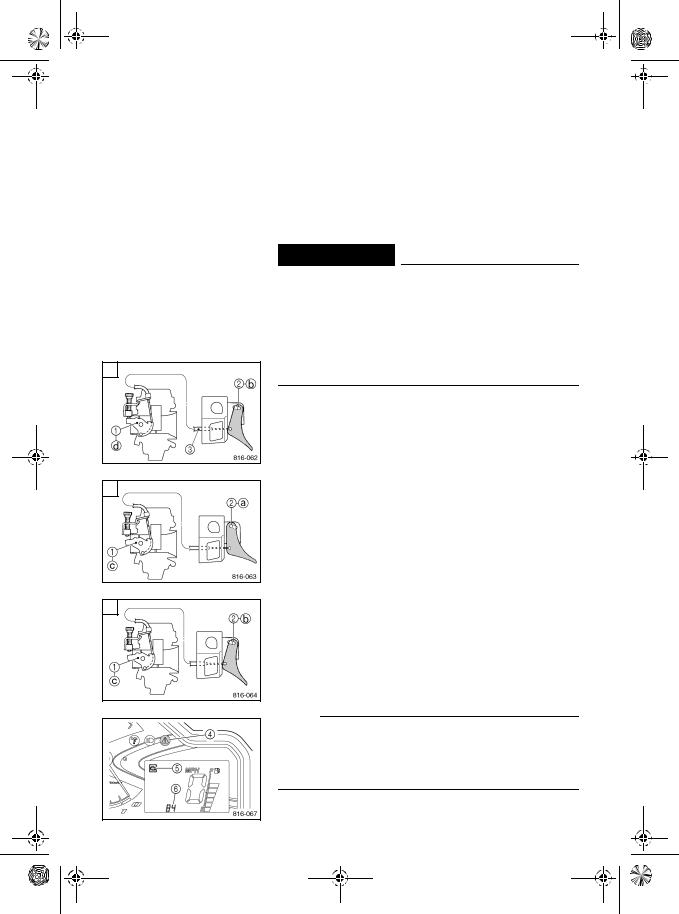
E_8gg.book Page 3 Thursday, March 16, 2006 4:23 PM
A
B
C
ESU04151
Throttle override system (T.O.R.S.)
If the carburetor or throttle cable should malfunction during operation, the T.O.R.S. will operate when the throttle lever is released.
The T.O.R.S. is designed to interrupt the ignition and keep the engine speed between 2,800 and 3,000 r/min if the carburetor fails to return to idle when the lever is released.
 WARNING
WARNING
●If the T.O.R.S. is activated, make sure that the cause of the malfunction has been corrected and that the engine can be operated without a problem before restarting the engine.
●Be sure to use the specified spark plug and spark plug cap. Otherwise, the T.O.R.S. will not work properly.
|
A |
Idling/ |
B |
|
C |
|
|
|
Running |
Trouble |
|||
|
starting |
|||||
|
|
|
|
|
||
|
|
|
|
|
|
|
Throttle switch |
|
Off |
|
On |
|
Off |
|
|
|
|
|
|
|
Throttle position |
Closed |
|
Open |
|
Open |
|
sensor |
|
|
||||
|
|
|
|
|
|
|
|
|
|
|
|
|
|
Engine |
|
Run |
|
Run |
T.O.R.S. |
|
|
|
will operate |
||||
|
|
|
|
|
||
|
|
|
|
|
|
|
È Idling/starting
É Running
Ê Trouble
1Throttle position sensor (throttle valve position)
2Throttle switch
3Throttle cable
aOn
bOff
cOpen
dClosed
NOTE:
When the T.O.R.S. is activated, the warning light 4 and self-diagnosis warning indicator 5 will flash and the twodigit code “84” 6 will flash in the tripmeter/odometer display.
5-3
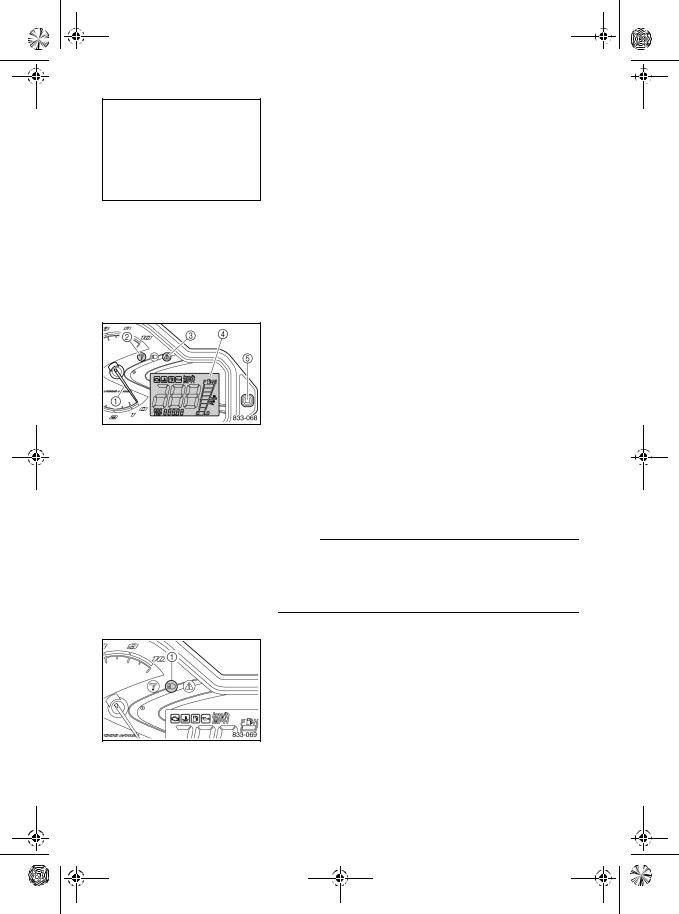
E_8gg.book Page 4 Thursday, March 16, 2006 4:23 PM
ESU04160
Speedometer unit
The speedometer unit is equipped with the following:
●a digital speedometer (which shows riding speed)
●an odometer (which shows the total distance traveled)
●a tripmeter (which shows the distance traveled since it was last set to zero)
●warning indicators (which show self-diagnosis, coolant temperature, fuel level, and oil level warnings)
●a fuel meter (which shows the fuel remaining in the fuel tank)
●a grip/thumb warmer level indicator (which shows the
grip warmer level or the thumb warmer level)
After the engine is started, the tachometer 1 makes one sweep, and the low coolant temperature indicator light 2, the warning light 3, and all segments of the meter 4 turn on and off once.
The grip warmer level is initially displayed for 5 seconds, then switches to the fuel meter display.
Odometer and tripmeter modes
Pushing the select/reset button 5 switches the display between the odometer mode “ODO” and the tripmeter mode “TRIP”.
To reset the tripmeter, push the select/reset button for at least one second while the tripmeter is displayed.
NOTE:
To switch the speedometer, odometer, and tripmeter displays between kilometers and miles, select the odometer mode “ODO”, and then push the select/reset button 5 for at least 10 seconds while the snowmobile is stopped.
ESU00363
High beam indicator light
The high beam indicator light 1 comes on when the high beams of the headlights are switched on. (See page 5-10 for headlight beam switch operation.)
5-4
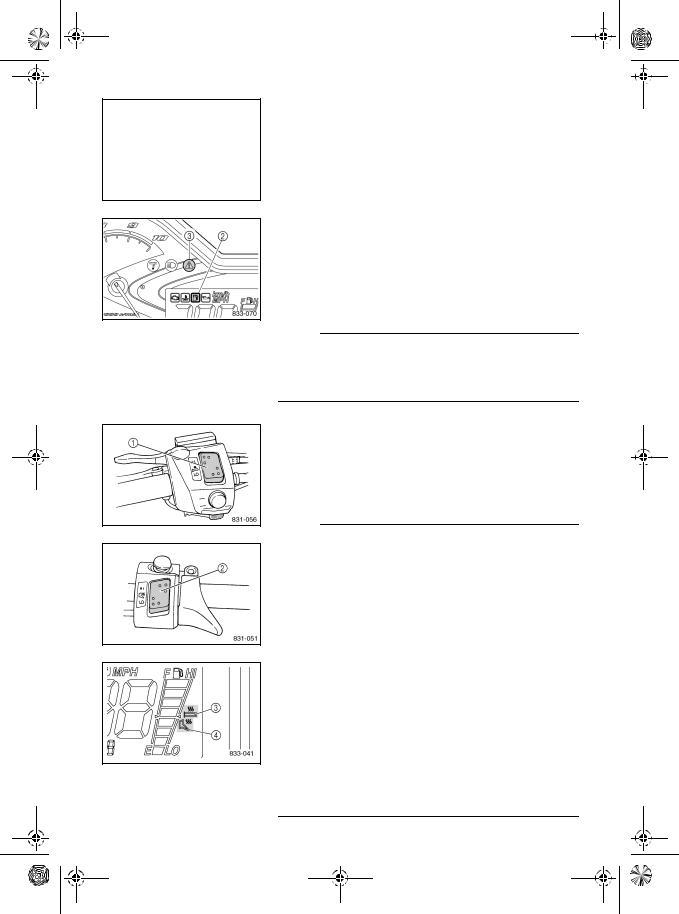
E_8gg.book Page 5 Thursday, March 16, 2006 4:23 PM
ESU03824
Fuel meter and grip/thumb warmer level indicator
The fuel meter and grip/thumb warmer level indicator have eight segments 1 which show the amount of fuel remaining in the fuel tank, the grip warmer level, or the thumb warmer level.
Fuel meter
As the fuel level decreases in the fuel tank, the segments disappear until the level goes down to the last segment “E” (Empty). When this occurs, the fuel level warning indicator 2 and the warning light 3 come on.
If the fuel level warning indicator and the warning light come on, fill the fuel tank at the first opportunity.
NOTE:
The snowmobile must be stopped on a level surface to obtain an accurate fuel meter reading, since the reading changes according to the movement and inclination of the snowmobile.
Grip/thumb warmer level indicator
The grip warmer adjustment switch 1 and the thumb warmer adjustment switch 2 control the electrically heated handlebar grips and throttle lever respectively.
To raise the temperature, press the respective switch to “HI”. To lower the temperature, press the switch to “LO”.
NOTE:
●The grip warmer indicator 3 comes on and the display switches to the grip warmer level when the grip warmer adjustment switch is pressed.
●The thumb warmer indicator 4 comes on and the display switches to the thumb warmer level when the thumb warmer adjustment switch is pressed.
●The grip/thumb warmer level is displayed for 5 seconds after releasing the grip/thumb warmer adjustment switch, then the display switches to the fuel meter.
●The top segment of the grip/thumb warmer level indicator flashes once when the grip/thumb warmer adjustment reaches the maximum level. The bottom segment of the grip/thumb warmer level indicator flashes once when the grip/thumb warmer adjustment reaches the minimum level.
●When the engine is started, the grip/thumb warmer levels are set to the levels saved when the engine was stopped.
5-5
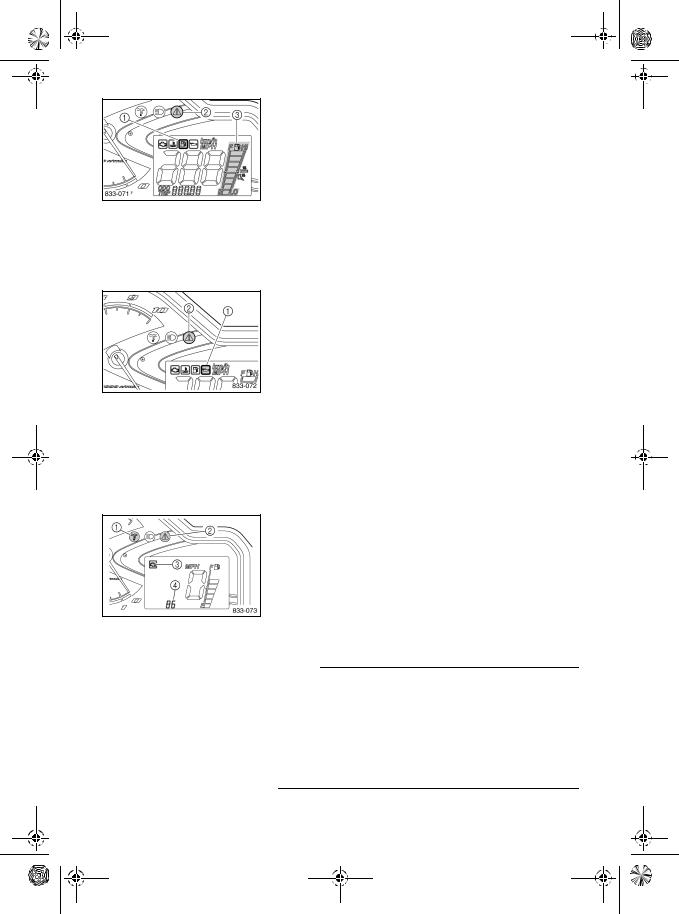
E_8gg.book Page 6 Thursday, March 16, 2006 4:23 PM
ESU04260
Fuel level warning indicator
The fuel level warning indicator indicates a malfunctioning sensor, disconnected coupler, broken lead, or short circuit when detected by the self-diagnosis device of the snowmobile.
The fuel level warning indicator 1, warning light 2, and all segments of the fuel meter 3 warn the rider of the above problems by flashing continuously.
When this occurs, have a Yamaha dealer inspect the snowmobile as soon as possible.
ESU00377
Oil level warning indicator
The oil level warning indicator 1 and the warning light 2 come on when the engine oil level is low.
If the oil level warning indicator and the warning light come on, place the snowmobile on a level surface and allow it to idle for one minute.
If the oil level warning indicator and the warning light go off, the engine oil level is sufficient, however it is getting low. Add engine oil as soon as possible.
If the oil level warning indicator and the warning light do not go off, check the engine oil level in the oil tank (see page 6-3), and add engine oil if necessary.
ESU04171
Low coolant temperature indicator light
The low coolant temperature indicator light 1 comes on when the coolant temperature is low and informs the rider that the snowmobile must be warmed up. After the engine is started, warm it up until the indicator light goes off.
The snowmobile can be operated normally after the indicator light goes off.
NOTE:
Operate the snowmobile at low speeds when the low coolant temperature indicator light is on. If the engine speed is too high, the warning light 2 and self-diagnosis warning indicator 3 will flash and the two-digit code “86” 4 will flash slowly in the tripmeter/odometer display. When this occurs, the engine control system prevents the engine speed from rising.
5-6

E_8gg.book Page 7 Thursday, March 16, 2006 4:23 PM
ESU04180
Coolant temperature warning indicator
If the engine overheats, the coolant temperature warning indicator 1 and the warning light 2 come on. When this occurs, stop the engine immediately and allow the engine to cool down, and then check the coolant level in the coolant reservoir. (See page 6-4.)


 CAUTION
CAUTION :
:



@
Do not operate the engine if it overheats.
ESU04254
Self-diagnostic system
This model is equipped with a self-diagnostic system for various electrical circuits.
If any of those circuits are defective, the warning light 1 and the self-diagnosis warning indicator 2 will flash, and then an error code (e.g., 16 and 81) 3 will flash slowly in the tripmeter/odometer display.
 WARNING
WARNING
●If the self-diagnosis warning indicator and warning light flash continuously, and an error code is displayed during operation, there may be some problem with the electrical circuit, lead couplers, etc.
●Stop the engine and allow it to cool off. Then, check that the wire harness couplers in the engine compartment are connected properly.
●If the self-diagnosis warning indicator, warning light, and an error code flash after the engine has been restarted, note the error code, and then have a Yamaha dealer inspect the snowmobile as soon as possible.
5-7
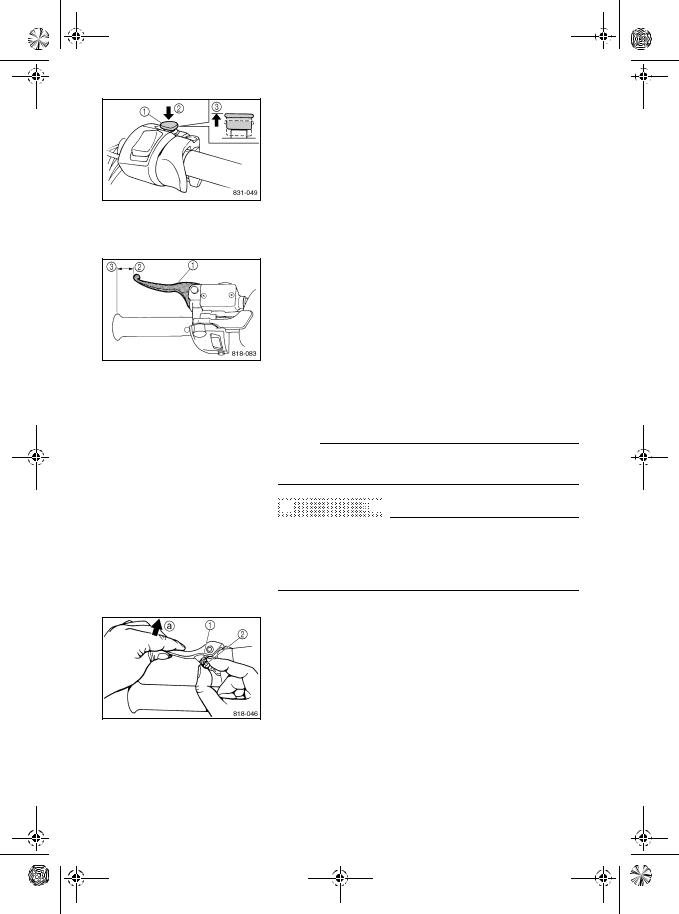
E_8gg.book Page 8 Thursday, March 16, 2006 4:23 PM
ESU00031
Engine stop switch
The engine stop switch 1 is used to stop the engine in an emergency. Simply push 2 the stop switch to stop the engine. To start the engine, pull 3 the stop switch and proceed with starting the engine. (See page 7-1 for more details.)
During the first few rides, practice using the stop switch so that you can react quickly in an emergency.
ESU02410
Brake lever
The snowmobile is stopped by braking the entire drive system.
Squeeze the brake lever towards the handlebar grip to stop the snowmobile.
1Brake lever
2Brake lever end
3Handlebar end
NOTE:
When the brake lever is operated, the brake light will illuminate.


 CAUTION
CAUTION :
:



@
Make sure that the brake lever end does not project out over the handlebar end. This will help prevent brake lever damage when the snowmobile is placed on its side for service.
For RS90N/RS90NR/RS90GT/RSG90GT
The brake lever is equipped with a position adjuster. To adjust the brake lever position:
1.Loosen the locknut 1.
2.While lightly pushing the brake lever in direction a, finger tighten the adjusting bolt 2 to set the brake lever to the desired position.
3.Tighten the locknut securely after adjusting the brake lever.
5-8
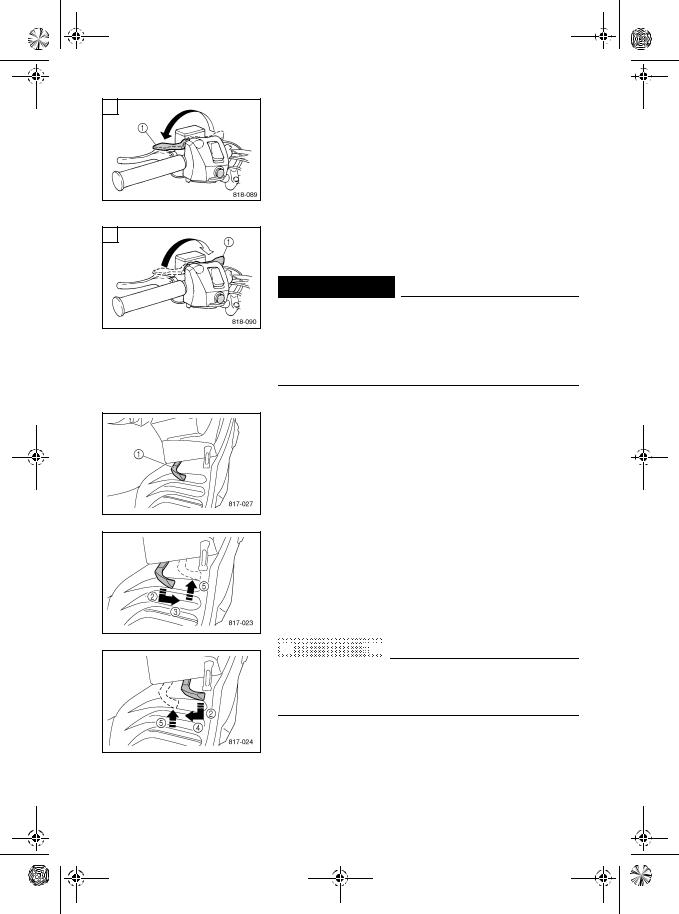
E_8gg.book Page 9 Thursday, March 16, 2006 4:23 PM
A
B
ESU00035
Parking brake lever
When parking the snowmobile or starting the engine, apply the parking brake by moving the brake lever 1 to the left.
To release the parking brake, move the parking brake lever 1 to the right.
È To apply the parking brake É To release the parking brake
 WARNING
WARNING
●Always set the parking brake before attempting to start the engine.
●Never run the snowmobile with the parking brake applied. This may overheat the brake disc and reduce braking ability.
ESU03411
Shift lever
For RS90R/RS90NR/RS90GT/RSG90/RSG90GT
The shift lever is used to put the snowmobile into forward or reverse. After coming to a complete stop, pull the shift lever out, slide it to “FWD” or to “REV” until it stops, and then release it.
1Shift lever
2Pull out
3Slide to “FWD” (Forward)
4Slide to “REV” (Reverse)
5Release


 CAUTION
CAUTION :
:



@
Do not shift from “FWD” to “REV” or from “REV” to “FWD” while the snowmobile is moving. Otherwise, the drive system could be damaged.
5-9
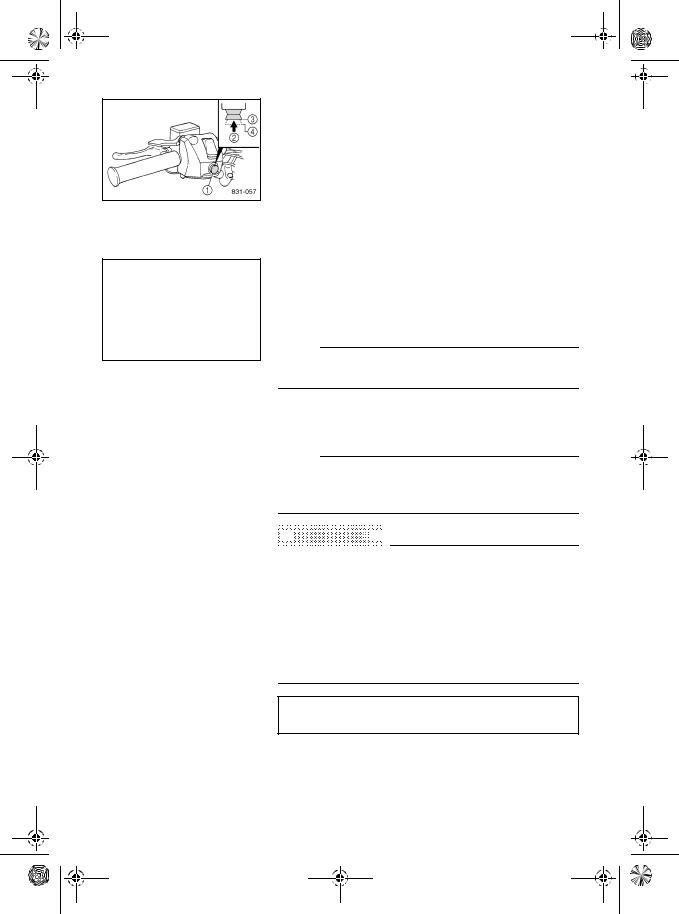
E_8gg.book Page 10 Thursday, March 16, 2006 4:23 PM
ESU00039
Headlight beam switch
Push the headlight beam switch to change the headlight beam to high or low.
1Headlight beam switch
2Push
3High beam
4Low beam
ESU04301
Auxiliary DC jack
For RS90GT/RSG90GT
The auxiliary DC jack is located in the front panel and can be used for accessories.
NOTE:
The auxiliary DC jack cannot be used if the engine is not running.
1.Start the engine.
2.Open the auxiliary DC jack cap 1, and then insert the accessory power plug into the jack 2.
NOTE:
After using the auxiliary DC jack, be sure to remove the accessory power plug from the jack and close the auxiliary DC jack cap.


 CAUTION
CAUTION :
:



@
●Do not use accessories requiring more than the maximum rated capacity for the auxiliary DC jack. This may overload the circuit and cause the fuse to blow. (See pages 8-37–8-39 for the specified amperage.)
●Do not use an automotive cigarette lighter or other accessory with a plug that gets hot because the jack can be damaged.
Maximum rated capacity:
DC 12 V, 2.5 A (30 W)
5-10
